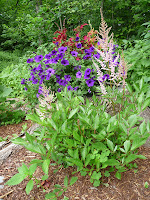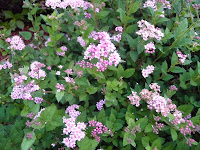While I'm already seeing changes in the landscape in preparation for the long winters rest; there is still so much to see, so much abundance in the garden.
 |
| Clethra alnifolia |
Walking up to my front door during bloom, one is immediatly captivated by the spicy scent it gives off. I know it almost always causes me to pause and take it in with a deep breath and widening smile.
 The blooms arrive in late July and August with multiple floretes that open progressively along 3" to 5" racemes.
The blooms arrive in late July and August with multiple floretes that open progressively along 3" to 5" racemes.This 5' to 6' deciduous shrub is rather compact and spreads by suckering. It prefers dappled light or partially shaded moist areas but is adaptable pretty much anywhere.
 |
| Diphylleia cymos |
The main attraction, however, are the blue berries that sit on red colored pedicels following the plants white flowers in June.
Really wild looking... I'm not sure the photo does it justice. Another really showy plant in bloom right now is this perennial Hibiscus 'Kopper King'. Beautiful coppery - red disected leaves, this plant stands tall at 3 to 4 feet.
Another really showy plant in bloom right now is this perennial Hibiscus 'Kopper King'. Beautiful coppery - red disected leaves, this plant stands tall at 3 to 4 feet.The flowers are huge! They're between 10" to 12" across, light pink with red veining and a bright red central eye.
Absolutely striking...even if they do only last for one day.
Be forewarned; this tends to be the very last plant to reappear in spring. Be patient and just before you're about to give up on it, a little sprout will appear. That's always a happy day!
Planting combinations of perennials with varying contrast along the same color palette is almost always a pleasing effect.
This bed of the common coneflower (Echinacea purpurea) and liatris spicata (more commonly known as blazing star or gayfeather) is a good example of a monochromatic planting.
As I've mentioned in the past, I'm really partial to spikey flowering plants and liatris really fits the bill and coneflowers, long held for their medicinal qualities, are a must have for any sunny summer garden.
Attractive to humans, hummingbirds, butterflies and bees... ;)
I can't take credit for this next combination and have no idea how the ajuga 'Caitlins Giant' (the larger leafed, bronzy colored plant) jumped into this patch of sedum 'John Creech' but one day I was walking past and it caught my attention. Who would have known?
As far as I'm concerned; nature just one upped me :)





































